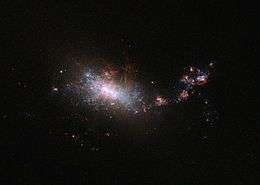NGC 1140
| NGC 1140 | |
|---|---|
 NGC 1140, imaged by Hubble | |
| Observation data (J2000 epoch) | |
| Constellation | Eridanus |
| Right ascension | 02h 54m 33.542s[1] |
| Declination | −10° 01′ 42.60″[1] |
| Redshift | 0.005007[2] |
| Helio radial velocity | 1150 km/s[2] |
| Distance | 59.47 ± 4.18 Mly (18.233 ± 1.283 Mpc)[2] |
| Apparent magnitude (V) | 12.25[2] |
| Apparent magnitude (B) | 12.84[3] |
| Absolute magnitude (V) | −19.05[2] |
| Characteristics | |
| Type | IBm pec[2] |
| Apparent size (V) | 1.7′ × 0.9′[2] |
| Notable features | Wolf–Rayet galaxy |
| Other designations | |
| Markarian 1063, VV 482, MCG-02-08-019, PGC 10966[3] | |
NGC 1140 is an irregular galaxy in the southern constellation of Eridanus. Estimates made using the Tully–Fisher method put the galaxy at about 59 million light years (18 megaparsecs).[2] It was discovered on 22 November 1786 by William Herschel, and was described as "pretty bright, small, round, stellar" by John Louis Emil Dreyer, the compiler of the New General Catalogue.[4]
NGC 1140 is a starburst galaxy, meaning it is forming stars at a very fast rate. In fact, while it is only a tenth as wide as the Milky Way, it is producing stars at a rate of 0.65 M☉/yr,[5] about the same as the Milky Way. The image taken by the Hubble Space Telescope shows bright blue and red regions of star formation, similar to NGC 1569.[6] The starburst is estimated to have began about 5 million years ago.[5] Its low metallicity (the ratio of hydrogen and helium to other elements) makes NGC 1140 similar to primordial galaxies.[6]
Wolf–Rayet stars, a class of blue, massive, and luminous stars, are present in this galaxy; in fact, NGC 1140 has so many of them that their spectra also appear in the galaxy's spectrum.[5] These types of galaxies are known Wolf–Rayet galaxies, and are fairly rare because Wolf–Rayet stars have short lives.[7]
References
- 1 2 Cutri, R. M. (2003). "2MASS All-Sky Catalog of Point Sources". VizieR On-line Data Catalog. Bibcode:2003yCat.2246....0C.
- 1 2 3 4 5 6 7 8 "NED results for object NGC 1140". National Aeronautics and Space Administration / Infrared Processing and Analysis Center. Retrieved 4 March 2017.
- 1 2 "NGC 1140". SIMBAD. Centre de données astronomiques de Strasbourg. Retrieved 4 March 2017.
- ↑ Seligman, Courtney. "New General Catalogue objects: NGC 1100 - 1149". cseligman.com. Retrieved 4 March 2017.
- 1 2 3 Karthick, M. Chrisphin; López-Sánchez, Ángel R.; Sahu, D. K.; Sanwal, B. B.; Bisht, Shuchi (2014). "Photometric and spectroscopic studies of star-forming regions within Wolf-Rayet galaxies". Monthly Notices of the Royal Astronomical Society. 439 (1): 157–178. arXiv:1311.7504. Bibcode:2014MNRAS.439..157K. doi:10.1093/mnras/stt2301.
- 1 2 "A galactic nursery | ESA/Hubble". www.spacetelescope.org. 2015. Retrieved 4 March 2017.
- ↑ "Intense and short-lived | ESA/Hubble". www.spacetelescope.org. 2015. Retrieved 4 March 2017.